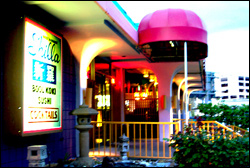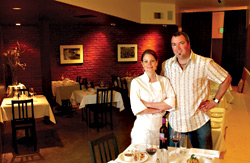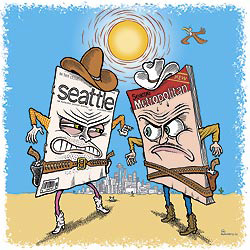In a city where one street can support eight sushi places and people consume pad Thai almost by osmosis, Asian food often seems to dominate the restaurant market. But even in pho-loving, sushi-crazed Seattle, one major culinary tradition receives little attention: Korean cuisine.
Despite the heavy restaurant concentration in the International District, Seattle’s Korean eateries are scattered throughout the city. A few cheapie spots line University Way; Kimchi Bistro on Broadway has its fans; and Korean fare is showing signs of life in Bellevue, Laurelhurst, and Pike Place Market (see sidebar). Still, we have nothing that even approaches Koreatown in Los Angeles, which teems with eateries and bars—reportedly close to 850. Now that Japanese, Thai, and Vietnamese have become commonplace, when can we expect the Korean food fad to hit Seattle?
It may never happen, as long as Korean restaurants lie in nondescript neighborhoods like Shilla does (located where Cascade meets the Regrade). But step inside and you’ll be greeted by warm, chatty service and an expansive menu that amounts to a syllabus for Korean Cuisine 101, divided into soups, stews, noodle and rice dishes, and marinated meat and seafood “broils” (including garlic-sesame beef, aka bul gho gi) to be cooked on the tabletop grill. (Each four-person booth is equipped with one.)
Humble surroundings notwithstanding, Shilla frequently serves as a rendezvous for visiting cultural emissaries, like Korean directors and actors in town for the Seattle International Film Festival. One reason might be its excellent panchan, or small plates. Not unlike Spanish tapas or Italian antipasto, the cold vegetable and fish concoctions that make up a panchan assortment—including kimchee (fermented cabbage, radish, or turnip), a widely recognized Korean specialty—provide strong flavors in tiny quantities, thus teasing the palate far more effectively than meal-sized American appetizers.
In his recent article “Koreatown’s Top 40,” LA Weekly writer Jonathan Gold proclaims: “To connoisseurs, a restaurant is best judged by the quality of its panchan.” According to this standard, Shilla rates high. Among its various types of kimchee, the daikon radish stands out. Fermentation obliterates a vegetable’s flavor, so spiciness, saltiness, and texture are the only criteria that matter, and the satisfying crunch and tangy taste of Shilla’s daikon kimchee are hard to beat.
Traditionally arranged in a circle or in parallel lines, panchan exemplify one of Korean dining’s many seeming contradictions: simple food served ceremoniously. Deborah Ro, a local Korean-American who grew up in a fairly traditional household, claims that what we think of as Korean cuisine is little more than “glorified peasant food,” since “there is no haute in Korean food.” (Gold’s findings in L.A. support this claim; such fusion inventions as “angel hair pasta in a kimchee cream sauce” are exceedingly rare, he reports.)
Sesame spinach, salty bean sprouts, and julienned sweet daikon accompany the fire-red radish and cabbage kimchee at Shilla, forming a flavor palette that anticipates tastes and aromas to come. In fact, what might be called “kimchee pairing”— choosing a suitable kimchee to precede and/or accompany a certain kind of dish—is a minor art form, as kimchee in Korea has about as many regional and seasonal variations as American greens.
Many societies quietly condone heavy drinking, but it takes a sophisticated culture to devise effective hangover cures. Korean cuisine has naturally incorporated various alcohol antidotes (most of them soups and stews), and Shilla serves quite a few. When a friend ordered hwang tae tahng, a mild soup made with dried fish, vegetables, and egg, our server informed us that her mother always kept some on hand in case her father should happen to stumble home in boozed-up reverie. Unlike the spicier meat and seafood stews, hwang tae tahng, with its understated flavor and velvety warmth, is accessible enough to qualify as Korea’s answer to matzoh ball soup.
Bi bim bap, on the other hand, is a kind of do-it-yourself one-dish meal, allowing each diner to make his or her own beautiful mess. Start with a single fried egg at the bottom of the bowl and build your dinner upside-down: Toss in marinated spinach, daikon, carrots and beef or fish, then crown the growing pile of ingredients with a serving of rice. Top the whole thing off with salty bean paste and pungent sesame oil, then mix it up. This colorful jumble of textures and flavors, with the egg as a marvelous protein kick, makes for a spirited gastronomic game of hide-and-seek.
Using words like “fad” to describe age-old cuisines seems wrong somehow. For whatever reason, Korean cooking has proved largely immune to the fusion and nouveau movements that have influenced—or transformed—our perception of Japanese, Chinese, Thai, and Vietnamese food. (For proof, consider the success of Wild Ginger, Typhoon!, and Chinoise.) Shilla serves one of the world’s most vibrant cuisines without pretense.
Restaurant Shilla, 2300 Eighth Ave., 206-623-9996, DENNY REGRADE $$. Lunch 11 a.m.–2:30 p.m., dinner 4:30–10 p.m. Mon.–Fri.; open 11 a.m.–10 p.m. Sat.–Sun.









